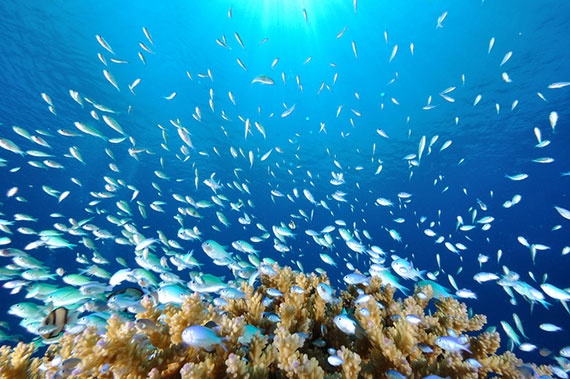Photography and underwater diving are both difficult hobbies to master. Joining them together into one activity results in a challenging but extremely rewarding endeavor. The water and waves are beautiful on their own, but with the addition of marine life such as fish, coral reefs, and other marine flora and fauna, your photography will reach a new level. The next best thing to diving among the underwater life is using photography to make a lasting record of that experience.

photo by Michio Morimoto
Underwater photography is not much different from land based photography, but there are unique challenges that it presents. The greatest of these is the water itself with its lower visibility and unique properties of light under the water. Listed below are some hints to help those developing their underwater photography skills.
1. Be comfortable underwater
It’s very important that the photographer is comfortable in the environment. In this case, it’s the body of water where the photographer is diving. The ability to swim well, and sometimes quickly, is a necessity. At times, it is necessary to keep up with the fish you’re attempting to photograph.
One of the best ways to gain security in the water is to practice first in a swimming pool. This is a safe and calm setting where you can experiment with camera settings, lenses, and other equipment that will be used in an underwater photography session. Photographing kids underwater in a pool is not that different from trying to photograph a moving fish.

photo by Ed Garcia
Additionally, the photographer needs to be comfortable using a snorkel or scuba equipment, depending on how deep the dive will be. If most pictures will be taken near the surface, a snorkel will work well. If the dive will be deeper, scuba gear will make it unnecessary to return to the surface to breathe. This should also be practiced in a pool before going into the ocean or other body of water.
2. Control your buoyancy
Knowing how to control your buoyancy when underwater is very important. This is another skill that can be practiced in a pool. As on land, it’s necessary to keep the camera steady. Underwater, this can be achieved by learning to use your breath to control their buoyancy in the water. When this is mastered, the photographer will be able to remain stationary in the water and hover in the area of his or her choice.
3. Know the marine life
In order to create a meaningful photograph, it’s necessary to be knowledgeable about the subject being photographed. With regards to the underwater environment, it’s helpful to know the types of marine life in the area and their typical behaviors. Is the area safe? Which creatures are harmless and which should be avoided? Studying swim patterns of fish will help to set up the perfect picture. What is a likely spot for some of the shy creatures to hide?
4. Use available light
As with photography done on land, the lighting used in underwater photography is one of the most important aspects of the photo shoot. For many photos, especially those taken near the surface, the natural light from the sun can produce some amazing pictures.

photo by Shawn
The deeper you dive, the less the light is able to penetrate the water. In these cases, you’ll rely on flashes or strobe lights. These lights help to bring out the bright colors of the fish or reef, and can freeze the action of a fish or other marine creature.
5. Use a color-correcting filter
Another trick used to obtain better underwater photos is to make use of a color-correcting filter. For example, use a red filter is attached to the camera lens to reduce the prevalence of blues and cyans that occur in photos taken in deeper water.

photo by Steve Childs
6. Get in close
One of the most common tips given to underwater photographers is to get as close to the subject as possible. Distance is hard to judge when looking through the camera underwater. What might seem close may not be so close after all. Because light has to travel from the camera to the subject and back again, shortening the distance between the two allows for brighter, clearer pictures.
7. Be patient
Underwater photography is not for those who are in a hurry. You must often wait for the subject to come to you. It takes time for the marine life to get used to a newcomer in their home. If given enough time, most will lose their fear, and you’ll be able to take shots of the normal activities of life in that particular area.

photo by Tchami
8. Enjoy yourself
This last tip is for all underwater photographers, whether they are just starting out or have many years of experience. You dive because you love to dive. You take pictures because you wish to share this spectacular underwater universe with those who have never had the chance to experience it. When your love of diving and skill as a photographer come together, there is no doubt that extraordinary photos will be the result.
Underwater photography is an awesome experience in itself. It’s also becoming a distinct form of art, just like portrait photography and street photography. Sooner or later, every underwater photographer will experience the thrill of taking that “once in a lifetime” photo. It’s never too early to start.
About the Author:
After his first encounter with the visual arts, Richard Gaspari developed a passion for photography and for framing moments. For Richard, the camera is like the third eye, but with more ISO and an excellent shutter speed. Now, he writes for CreativePhotoConnect, where he tries to “train” others to frame high resolution moments.
Like This Article?
Don't Miss The Next One!
Join over 100,000 photographers of all experience levels who receive our free photography tips and articles to stay current:






Leave a Reply